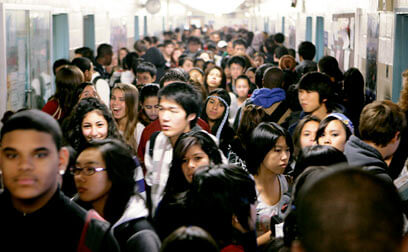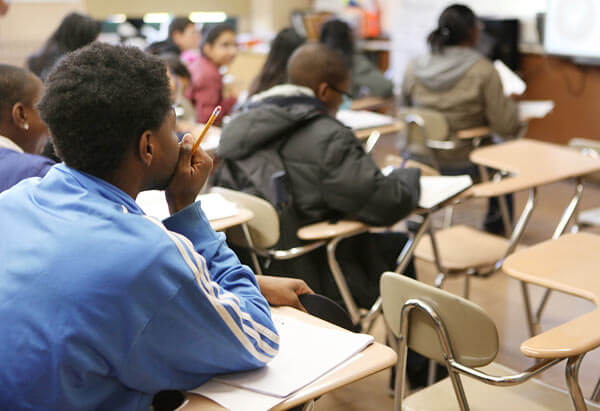By Rich Bockmann
With more than 290,000 students attending the borough’s public schools last year, Queens had the second-highest enrollment across the city.
Queens is also the most overcrowded borough, and the city’s School Construction Authority is the organization tasked with building out capacity for current students and those to come, and there are a lot more coming.
In order to stay ahead of the curve, the authority has hired two consulting firms to take a look at the city’s historical demographic data and project how many students are headed toward the public schools in the future, and where they will be.
Enrollment is affected by factors such as the economy, housing trends or immigration laws, so the projections are subject to change if, for example, the city’s next mayor enacts new educational policies. And particularly in areas of the borough where there are large numbers of undocumented immigrants, it can be hard to create an accurate forecast.
So while the projections sometimes arrive at different figures, they do agree on one thing: Queens’ schools will grow more than those in any borough and by the middle of the decade, the county will have the largest high school population.
Going back to 1972, when New York City’s public school population peaked at 1.14 million students, enrollment started to decline drastically over a period of ten years, bottoming out in 1982 at a little more than 918,000.
Over the next several years the city saw gradual gains until 1990, when enrollment shot up drastically again for ten years, leveling out at about 1.1 million at the beginning of the new century.
After 2000 the number of students dipped gradually over eight years, leveling out and fluctuating around the 1 million mark around 2008.
But while the city’s overall enrollment has been oscillating in the latter half of the aughts, Queens has been a different story.
Beginning in 2006 the borough started seeing an increase in the number of students that has sustained itself even as the city’s dipped down slightly this year.
Factors contributing to Queens’ growth have been positive net migration (more people moving into the borough than out of it) and a large natural increase (more births than deaths) in the population.
But Brooklyn has had even bigger gains in those areas and saw its student enrollment go down while Queens’ has risen. So what accounts for the difference?
Queens by far has the largest number of foreign-born residents of any borough in the city, and in terms of its student body it has the largest combination of Hispanics and Asians, the two ethnic groups that are growing fastest and projected to grow the most into the 20s.
No other borough has seen the sharp increase starting in 2006 in these two student groups that Queens has.
Through 2021 the city is expected to add more than 58,000 students in its schools, and about 50 percent of that growth is expected to happen in Queens.
Out of the borough’s seven pre-kindergarten-through-eight-grade school districts, six will have more students through the decade with western Queens’ District 24 — covering neighborhoods such as Corona, Elmhurst, Middle Village, Ridgewood and Glendale — leading the way.
Expected growth of more than 7,000 students through 2021 in and of itself would put the district in the construction authority’s sights, but considering the fact that District 24 is already the most overcrowded in the borough and one of the most overcrowded in the city, it is sure to be near the top of the DOE’s to-do list.
City Schools Chancellor Dennis Walcott has said addressing overcrowding in western Queens is one of the department’s top priorities, and one of the ways it is doing that is through its five-year capital plan.
Through the plan, the department has identified 11 projects that will add 5,199 seats to District 24 by the time they are completed in 2016, including a 1,100-seat elementary school in Corona. Nick Comainni, president of District 24’s Community Education Council, said the biggest contributor to overcrowding in the Corona and Elmhurst area is the prevalence of illegal sublets.
“You’ve got a one-family home with seven families living in it. The census comes out and can’t get an accurate count. We just don’t know what the true numbers are in this area.”
Comainni said rezoning could alleviate some of the district’s overcrowding, but he sees enforcement of the city’s housing laws as the best solution.
The borough’s second-most overcrowded area, District 30, is projected to either lose 985 students or pick up 173 by next decade.
The district covers Astoria, Long Island City, Woodside, Sunnyside, Jackson Heights and East Elmhurst. The DOE plans to add 3,717 seats through 10 projects by 2016.
District 25 — covering Flushing, Whitestone and College Point — should add between 3,059 and 3,730 pupils. The DOE plans to add 982 seats.
District 26 — covering Bayside, Auburndale, Little Neck, Douglaston, Oakland Gardens, Bellerose, Floral Park and Fresh Meadows — is projected to gain between 1,344 and 1,742 students. Through one project scheduled to be completed by July the city plans to add 416 seats.
District 27 — encompassing the Rockaway Peninsula, Broad Channel, Howard Beach, Woodhaven, Ozone Park and parts of Richmond Hill, South Ozone Park and South Jamaica — is expected to pick up between 997 and 1,287 students. The city currently has plans for 860 new seats.
District 28 — covering Rego Park, Forest Hills, Briarwood, and parts of Jamaica, South Jamaica, Richmond Hill and Ozone Park — is projected to add between 1,836 and 2,411 students. There are currently no projects planned for the district.
District 29 — which covers Queens Village, Cambria Heights, Rosedale, Laurelton, St. Albans, Hollis and parts of Springfield Gardens, Jamaica and Jamaica Estates — is expected to either lose 63 or gain eight students. The city plans to add 1,103 seats.
The borough’s high schools are expected to experience significant growth as well.
Queens will likely add more than 12,000 high school students through 2012, growing more than 16 percent, while the other boroughs remain under 8-percent growth.
In 2017 Queens’ high school enrollment is projected to surpass that of Brooklyn’s, making it the borough with the largest high school roll.
Reach reporter Rich Bockmann by e-mail at rbockmann@cnglocal.com or by phone at 718-260-4574.

































